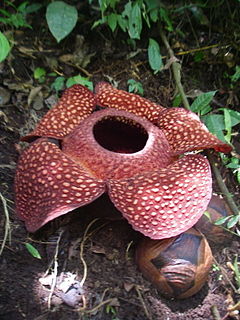
Rafflesia is a genus of parasitic flowering plants in the family Rafflesiaceae. It contains approximately 28 species, all found in Southeast Asia, mainly in Indonesia, Malaysia, Thailand and the Philippines. To Western Europe, it was first discovered by French surgeon and naturalist Louis Deschamps in Java between 1791 and 1794, but his notes and illustrations, seized by the British in 1803, were not available to western science until 1861. It was later found in the Indonesia rainforest in Bengkulu, Sumatra by an Indonesian guide working for Joseph Arnold in 1818, and named after Sir Stamford Raffles, the leader of the expedition.
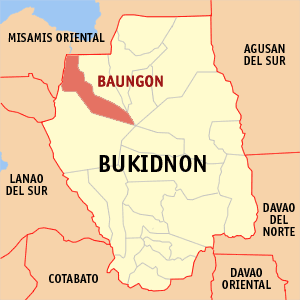
Baungon, officially the Municipality of Baungon, is a 2nd class municipality in the province of Bukidnon, Philippines. According to the 2015 census, it has a population of 34,336 people.

The Rafflesiaceae are a family of rare parasitic plants comprising 36 species in 3 genera found in the tropical forests of east and southeast Asia, including Rafflesia arnoldii, which has the largest flowers of all plants. The plants are endoparasites of vines in the genus Tetrastigma (Vitaceae) and lack stems, leaves, roots, and any photosynthetic tissue. They rely entirely on their host plants for both water and nutrients, and only then emerge as flowers from the roots or lower stems of the host plants.
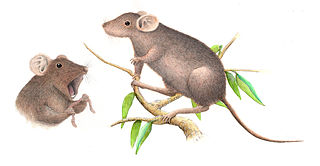
Apomys, commonly known as earthworm mice, is a genus of rodent endemic to the Philippines. Mice belonging to this genus are generally called Philippine forest mice and can be found on most islands of the Philippines except in Palawan, the Sulu Archipelago, and the Batanes and Babuyan group of islands.

The shrewlike rats, genus Rhynchomys, also known as the tweezer-beaked rats are a group of unusual Old World rats found only on the island of Luzon in the Philippines. They look a great deal like shrews and are an example of convergent evolution. Shrewlike rats evolved to be vermivores (worm-eaters) and insectivores feeding on soft-bodied invertebrates associated with leaf litter.

Pieter B. Pelser is a Lecturer in Plant Systematics and the curator of the herbarium at the University of Canterbury in Christchurch, New Zealand. One research interest is the evolutionary history of the tribe Senecioneae, one of the largest tribes in the largest family of flowering plants. He wrote the most recent attempt to define and delimit this tribe and its problematic founding species Senecio. He also studies insects that eat these plants (Longitarsus) which contain pyrrolizidine alkaloids and what makes them choose which plants they eat.
Rafflesia philippensis is a parasitic plant species of the Rafflesiaceae family that was named by Francisco Manuel Blanco in his Flora de Filipinas in 1845. The species is known only from a mountain located between the provinces of Laguna and Quezon, Luzon where it was first discovered. Its plant host is Tetrastigma pisicarpum. This species went unnoticed since its first description by Blanco but was rediscovered in 2003 by members of the Tanggol Kalikasan, a local environment conservation group in Quezon province who first saw and photographed the open flower of this species. It was brought to the attention of Manuel S. Enverga University (MSEUF), who formed a team composed of students and faculty to document the newly discovered Rafflesia species.
Rafflesia baletei is a parasitic plant species of the genus Rafflesia. It is endemic to the Philippines.
Rafflesia leonardi is a parasitic plant species of the genus Rafflesia. It is endemic to the Philippines. R. leonardi is the fourth Rafflesia species found in Luzon and the eighth from the Philippines. It is called ngaratngat by the local Agta tribesmen.
Rafflesia lobata is a parasitic plant species of the genus Rafflesia. It is endemic to the Philippine island of Panay, particularly the mountains of Antique and Iloilo provinces. This is the second species recorded from the island of Panay. One of the most distinctive features of Rafflesia lobata is that some populations have flowers with a lobed diaphragm that opens outward. Nearly all other Rafflesia species have diaphragms that curve inward. This feature is polymorphic in R. lobata. As shown in the photos below, in some populations the diaphragm curves inward and may be 3- or 6-lobed. Note the 6-lobed flower also has 6 perigone lobes. It remains to be seen whether flower merousity has phylogenetic significance that should be taxonomically recognized. Some populations of R. manillana, such as one at Bolos Point, Cagayan Valley, Luzon, also have flowers with lobed, outwardly curving diaphragms.
Rafflesia manillana is a parasitic plant species of the genus Rafflesia. It is endemic to the Philippines.

Rafflesia schadenbergiana is a parasitic plant species of the genus Rafflesia. Known as "bó-o" to the Bagobo tribe and "kolon busaw" to the Higaonon tribe of Bukidnon, it has the largest flower among the Rafflesia species found in the Philippines with a diameter ranging from 52-80 centimeters. It has also the second largest flower in the genus after R. arnoldii.

Rafflesia speciosa is a parasitic plant species of the genus Rafflesia. It is endemic to the Philippine island of Panay. R. speciosa is the third Rafflesia species documented to exist in the Philippines, after R. manillana and R. schadenbergiana. It belongs to the medium-sized Rafflesia. The species was named by Julie Barcelona and Edwino Fernando.

Sibalom Natural Park is a 5,511.47-hectare (13,619.1-acre) protected area in the Philippines on the island of Panay in the municipality of Sibalom, Antique. It was proclaimed a natural park on 23 April 2000. It is considered as one of the last remaining lowland rainforests on Panay.

Rafflesia verrucosa was first identified and characterized during a small mammal survey of Mt. Kampalili in eastern Mindanao in 2010. R. verrucosa is the tenth species of Rafflesia found in the Philippines. Rafflesia species have rare and unusual flowers known for their large size and pungent smell. Some plant enthusiasts like Frits W. Went have gone to extreme measures to see these plants in bloom. Went detailed his search for Rafflesia saying,
"I had heard, when I was in Java many years ago, that Rafflesia were to be found on an offshore island named Nusah Kembangan. This was in 1929, when it was a penal colony for major criminals. My driver on this occasion was a convicted murderer, and my guide was serving time for cannibalism."
Julie F. Barcelona is a Filipina botanist, working as Research Associate at University of Canterbury.
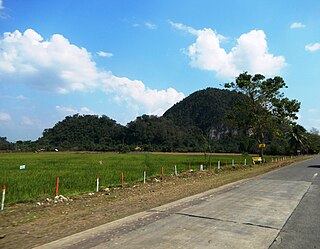
The Quirino Protected Landscape is a protected area in the Philippine island of Luzon that covers a large portion of the province of Quirino. It was established in 2004 to preserve the watershed area containing the headwaters of the Cagayan River, also known as the Rio Grande de Cagayan, which supports major irrigation systems in the entire Cagayan Valley region. From an initial area of 206,875.41 hectares, the protected area now forms a total aggregate area of 175,943.62 hectares divided into three parcels after a 2005 amendment opened up a few areas to mining. It is a key biodiversity area of the Sierra Madre Biodiversity Corridor.
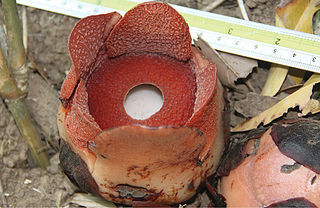
Rafflesia consueloae is a parasitic plant species of the genus Rafflesia endemic to the island of Luzon in the Philippines. It is the smallest species of the genus Rafflesia.

Daniel Lee Nickrent is an American botanist, working in plant evolutionary biology, including the subdisciplines of genomics, phylogenetics, systematics, population genetics, and taxonomy. A major focus has been parasitic flowering plants, particularly of the sandalwood order (Santalales). His interest in photographic documentation and photographic databases has led to several photographic databases including Parasitic Plant Connection, Phytoimages, Plant Checklist for the Rocky Mountain National Park, and Plant Checklist for the Crab Orchard National Wildlife Refuge.
Danilo S. Balete, also known as Danny Balete, is a Filipino zoologist and biologist. His is known for his work on the Philippines' endemic mammal species. He pursued the question of what determines species diversity. The research by Balete and his team overturned previously held notions that diversity decreased in mountainous regions, showing that harsh environments could generate, rather than suppress, species diversity.












